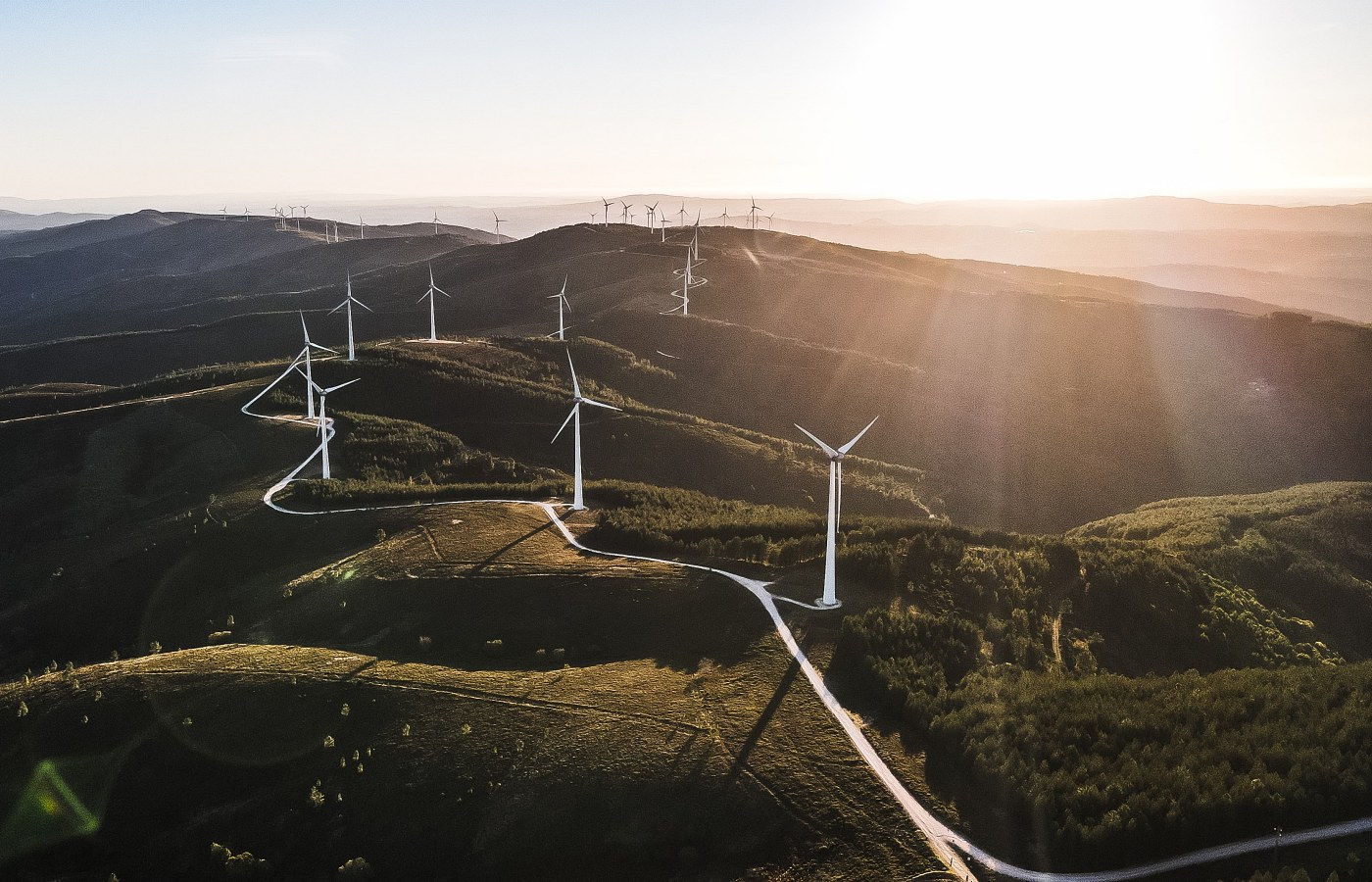One of the most beautiful areas outside of the foothills of Alberta, zoned for agriculture, is now slated for massive industrial wind turbine projects. Not only will this permanently marr the beauty of the Lakeland area, but it will jeopardize the health of residents and livestock, according to the latest studies and research. The Northland Power project will start with 35 turbines, with potential to almost triple that size, just north of Elk Point. (UPDATE: the Northland Power project has been officially cancelled. See here.) Across the river to the south, Elemental Energy is seeking to install, at first, 15 wind turbines from Willow Range Road and south.
While several countries and regions are calling for a 2km setback zone from turbines — based on scientific studies and data with health complications for nearby residents — the Northern Valley Wind Power Project’s setbacks are unclear at this point. I
In the technical letter “Wind energy turbines and sound exposure in the audible and IFLN range: high evidence for severe health disturbances according to current studies” (Sept. 2022) published on PubMed’s National Library of Medicine and in Thieme Journal, it refers to the current peer-reviewed analysis by Dumbrille et al. “Wind turbines and adverse health effects: Applying Bradford Hill’s criteria for causation”.
The Bradford Hill (BH) criteria are the internationally recognized standard for assessing a causality between an environmental medical stressor and health disorders. They are made up of the following 9 criteria: strength of association, consistency, specificity, temporal profile, biological gradient (dose-response), plausibility, coherence, experimental evidence and analogous evidence. The main conclusions of the study are:
- Across all continents, the same pattern of complaints [of wind turbines] could be shown in chronically exposed persons.
- Reports of negative effects on animals, which are known not to show any nocebo effect and which live close to wind turbines, resulted not only in stress reactions, but also in also negative effects on fertility, development and reproduction. Reports from the USA, Canada, Denmark, Japan, Portugal, France, Taiwan and Great Britain indicated teratogenic and mutagenic effects (see Appendix Dumbrille et al.).
- With regard to the “dose-response” criterion, analyzes showed a demonstrable deterioration in the mental performance of residents living within 1.4 km of the wind turbine(s) and those outside Radius.
- From the conclusions, important questions arise about the determination of a cumulative dose of sound, including infrasound and low-frequency sound (ILFN) for adults, the elderly and especially fetuses and small children.
Applying the BH criteria to the IWT (industrial wind turbines)-related clinical, biological, and experimental data, demonstrates that the exposure to IWTs is associated with an increased risk of AHEs (adverse health effects). This analysis concludes that living or working near IWTs can result in AHEs in both people and animals.
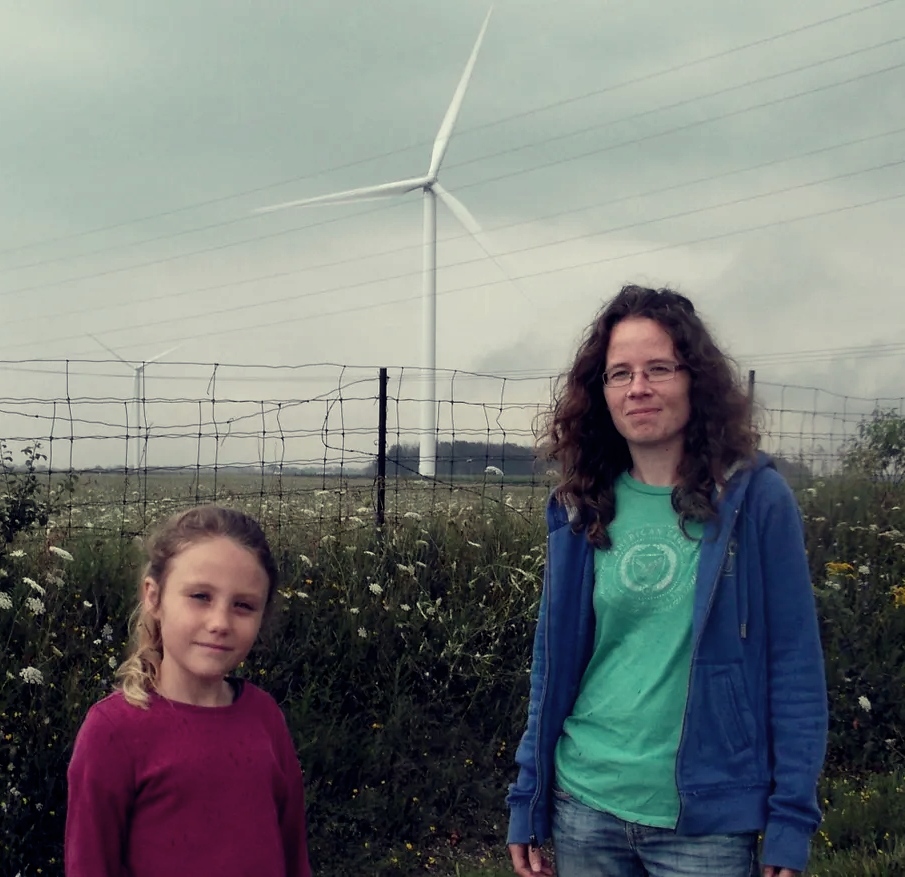
living near Kerwood, Ontario
(PHOTO: Colin Graf/Toronto Star)
In Ontario, residents near wind turbines reported insomnia, nausea, headaches, and heart problems since the erection of wind projects there, with several residents forced to evacuate their homes. A study published in the reputable Nature journal in September 2021 found “adverse health impacts of LFN (low frequency noise) exposure”. Residents of the nearby wind farms off the coast of New Jersey — where whales are suddenly dying (February 2023) after wind projects there became operational — have complained of their homes “shaking” as a result of the turbines — another common complaint. An exhaustive investigation and report by cardiologist, Dr. Ben Johnson, notes that the term “annoyance” is utilized in several studies, including a Health Canada report. Health Canada admits that, “Excessive exposure to noise, even for short durations, can have potential health effects. Significant, adverse, irreversible effects usually occur gradually in response to excessive exposure to noise.” Dr. Johnson notes that the World Health Organization (WHO) defines “health” as a state of complete physical, mental and social wellbeing. “Adverse health consequences of environmental noise can be the asymptomatic (unrecognized) development of hypertension or vascular atherosclerosis or insulin resistance or can be much simply defined as the “the loss of wellbeing”,” states Dr. Johnson, adding: “IWTs cause adverse health effects with that definition being consistent with WHO definitions and currently practiced health care… all 9 of The Bradford Hill criteria have been identified in the scientific literature as pertinent to the relationship between IWT noise and AHEs.“
A recent judgment of a French court of appeal of July 8th, 2021, based on an expert report, determined a change in the state of health of residents close to wind turbines and concluded:
“The “Cour d’appel de Toulouse”, a French Court of Appeal, made a higher court decision with a now published judgment of July 8, 2021 and overturned a judgment of the “Tribunal de Grande Instance”. It proved that the clerks who live in the vicinity of 6 wind turbines were right and determined that the operation of the turbines at a distance of 700 m to 1300m led to health problems . The court found the typical symptoms: headache, painful pressure on the ears, dizziness, weakness, tachycardia, tinnitus, nausea, nosebleeds and insomnia. After a corresponding examination, the Court of Appeal stated in its judgment that the Kleigers suffered from the so-called “wind turbine syndrome”, which can be traced back to low-frequency noise and infrasound. It awarded them a claim for damages of €128,000.
November 8, 2021; theconexxion.com; cf. September 7th, 2022; windaction.org
The decision may also have significance for Canadian legal practice, even if there is no legally binding effect. As stated above, there has also been shown to be a “demonstrable deterioration in the mental performance of residents living… outside Radius.” This, therefore, concerns both my family and my neighbours who are well within a 2km radius of the proposed project. “The sound generated by large wind turbines can be heard up to a mile away (1609 m).”
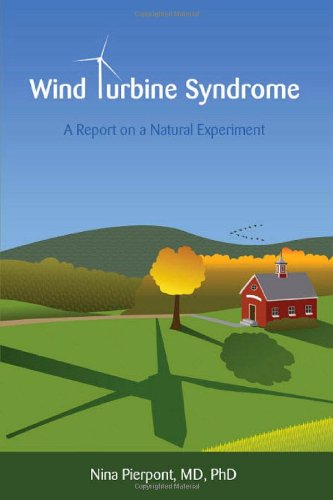
This has vindicated the work of Dr. Nina Pierpont, a leading New York pediatrician who trained at Johns Hopkins University School of Medicine and earned her Ph.D. in Population Biology from Princeton University. Her research warned in 2009 that wind turbine syndrome (WTS) was a real phenomenon. She studied symptoms of people living near wind turbines in the US, the UK, Italy, Ireland and Canada for more than five years. She found the disruption or abnormal stimulation of the inner ear’s vestibular system by turbine infrasound and low-frequency noise or visceral vibratory vestibular disturbance (“VVVD”). Problems range from internal pulsation, quivering, nervousness, fear, a compulsion to flee, chest tightness and tachycardia – increased heart rate. Turbine noise can also trigger nightmares and other disorders in children as well as harm cognitive development in the young, she claimed. However, Dr. Pierpont also made it clear that not all people living close to turbines are susceptible. Nonetheless, the syndrome has been widely panned at best as psychosomatic — or worse, some kind of group hysteria. This does not surprise Pierpont:
There is no doubt that my clinical research shows that the infrasonic to ultrasonic noise and vibrations emitted by wind turbines cause the symptoms which I am calling Wind Turbine Syndrome. There are about 12 different health problems associated with WTS and these range from tachycardia, sleep disturbance, headaches, tinnitus, nausea, visual blurring, panic attacks with sensations of internal quivering to more general irritability.
The wind industry will try to discredit me and disparage me, but I can cope with that … The wind industry, however, is not composed of clinicians, nor is it made up of people suffering from wind turbines.
Are wind farms a health risk? US scientist identifies ‘wind turbine syndrome’, The Independent, August 2, 2009
It is also highly significant that residents in areas where wind turbine projects have been installed have reported dramatic decreases in property values — this while a handful of landowners receive exorbitant royalties at the expense of their neighbour’s health and property values. We are not speaking, for example, of oil tanks that are only within view at certain vantage points, but of massive 120 m high structures (approx. 36 stories) that can be seen for miles.
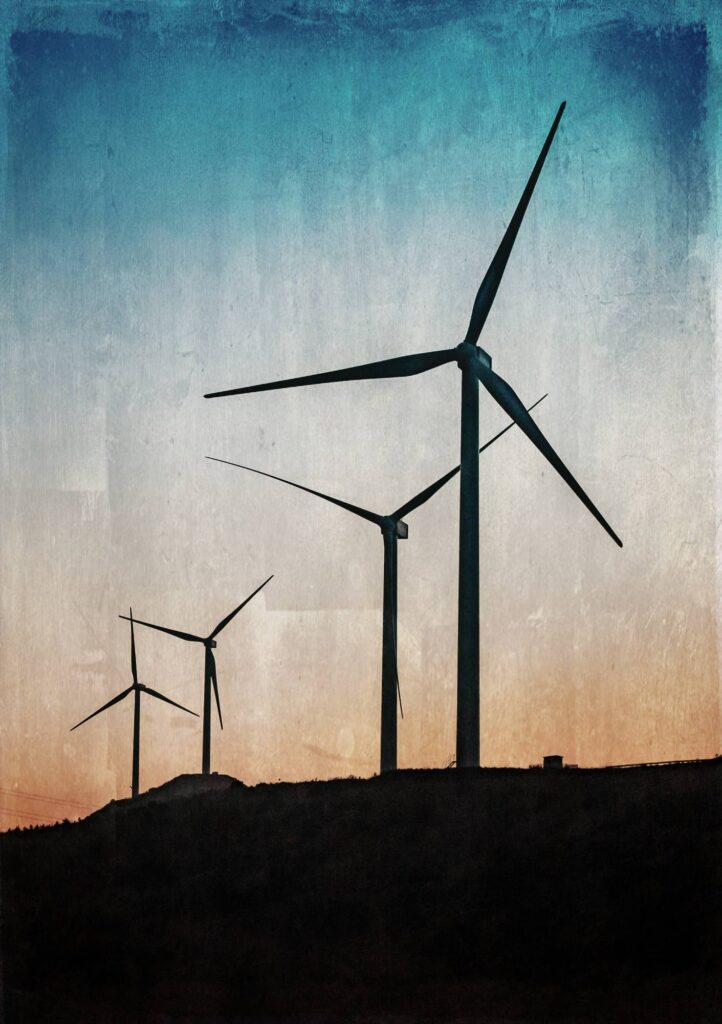
How is the province of Alberta, Elemental Energy, and Northland Power going to compensate those home owners, who will live under the shadow of these so-called “Green” projects, for potential adverse health effects, not to mention a drop in property values that has been observed where wind farms have been established?
I say “so-called” because the environmental harm is well-documented. Since the Lakeland region (and her lakes) are host to millions of migratory birds, it is no small thing that studies have found that millions of birds are being killed annually,1 as well as a “massive decline” in seabirds,2 where wind turbines exist.3 It is estimated that a single wind turbine can kill up to 40 million insects annually, further destabilizing ecosystems. One study concluded that “Approximately 1200 billion flying insects are struck each year as they fly through the rotors of wind farms in Germany. Such a large number of affected insects could be a relevant factor for the stability of the insect population and could thus influence species protection and the food chain,” warns Dr. Franz Trieb of the German Aerospace Center. In France, farmers are reporting livestock near wind turbines to be dying. In Ontario, a farmer disturbingly reported that turbines are destroying earth worms in his soil. Bats, sea-life, and micro-ecosystems have all been adversely affected. According to a 2017 study published in the scientific journal Waste Management, the world’s wind industry will be producing 43 million tons of blade waste annually by 2050 — most of it ending up in landfills. ‘If you really hate nature,” stated journalist James Delingpole, “you’ll love wind farms. Not only do they destroy the landscape, blight views, increase flooding but… they kill rare birds and bats on an industrial scale.”
Moreover, Bisphenol A (BPA) is one of the main constituents of turbine blades, which “shed” this material into the soil and waterways as protective resins break down. As early as 2012, the World Health Organization (WHO) warned the world about the possible carcinogenic properties of endocrine disruptors, such as BPA, concluding that these substances pose a global threat to public health. To build a wind farm along the sloping valleys to the North Saskatchewan river in the Elk Point region, and on productive agricultural land, is hazardous. Small concentrations of BPA damages the fertility of humans and all organisms. With turbine blades that reach speeds at the far end of the blade up to 300 km/h and above, wear increases significantly when they come in contact with rain, dust, salt particles, snow, heat and hail. One gram, which can make 10 million liters of water toxic, makes wind turbine blades a serious environmental hazard that few are talking about: each wind turbine blade releases from 0.5 to 2.5 grams of pure Bisphenol A per year. “Bisphenols are not covalently bound to the polymeric structure, from which with time, or due to physical and / or chemical factors such as heat and acidity, can be gradually released into the external environment, contaminating water, soil and sediments, and later the rest of the agro-food chain.”4
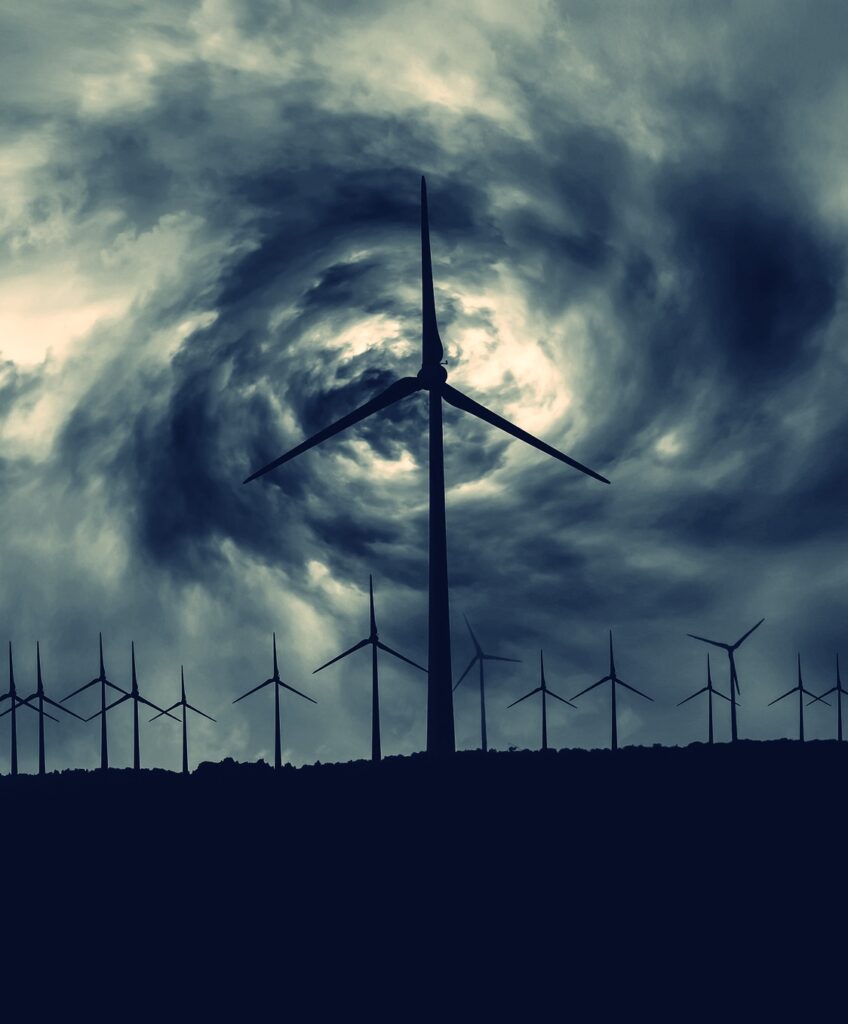
Finally, a recent report by the Fraser Institute says a move to convert Alberta’s energy grid to renewable power would result in ‘substantial costs’ for rate payers. Indeed, in Ontario, ratepayers have reported significant increases in their electricity bills, as much as by 71%, despite the massive implementation of wind farms there. The reason being that wind farms are being paid as much as 8 times the rates for their electricity than conventional power generators. In the words of Canadian economist, Prof. Ross Mekitrick, wind turbines “don’t run on wind, they run on subsidies.” Unlike the oil industry, which has learned to extract and produce affordable and ever cleaner energy through technological advances in end-use applications, and who can produce long-term jobs and massive profitability to the province… wind energy produces miniscule long-term employment while padding the pockets of “clean energy” startups and a handful of land owners. Recent data from Alberta reveals that the cold temperatures that Northern Alberta and other parts of the province consistently reach, are significantly reducing wind power output. (I also spoke with a farmer in this region who has already done an independent analysis of wind potential and he found that wind energy was far below any economic advantage; he installed solar power instead. Having moved from windy Saskatchewan, this does not surprise me at all, having spent a year here now).
Landowners and residents in the Elk Point region have suffered enough with the destruction of the oil industry and subsequently its economy; we don’t need further destruction of our property values and environment.
It’s quite a thing to be asked to live next to these massive turbines without any compensation or recognition of their effects at all.
Justin Helland, Rancher near Lomond wind farm project
February 5, 2020, wind-watch.org
Comments we found on YouTube…
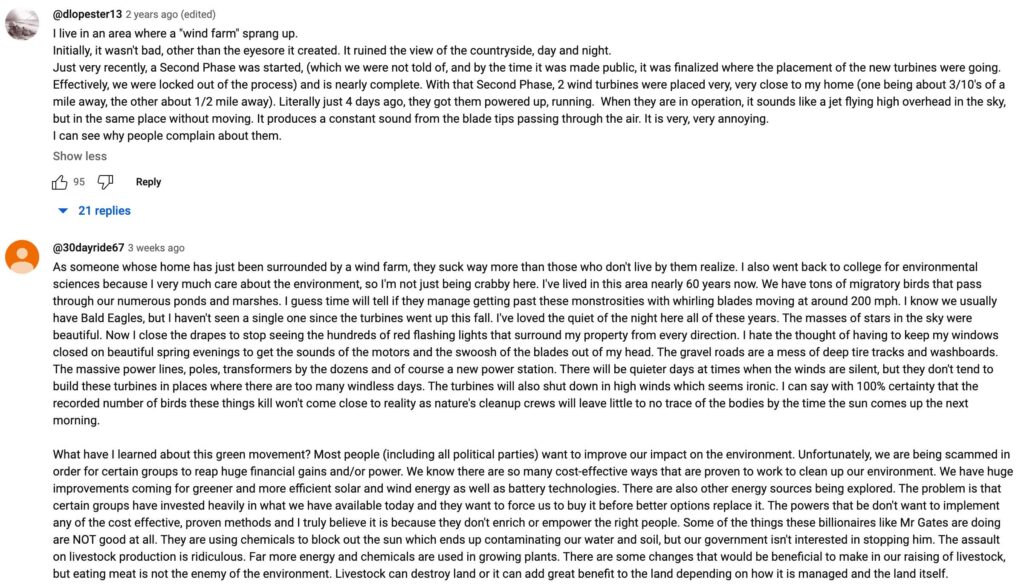
- cf. “New Evidence Shows Wind Turbines Cut Growth in Vulnerable Bird Populations by up to 20%”, dailyskeptic.com; cf. abcbirds.org/blog21/wind-turbine-mortality/[↩]
- A new study, funded by the European energy company Vattenfall, claims that not a single sea birds collides with offshore wind farms. Unfortunately, their press release provides no data or links to their study and wildly conflicts with other studies. Compare to this, this, this, and this.[↩]
- Note: It is also true that power lines, high-rise structures, cats, etc. also destroy billions of birds each year. But should we exponentially increase the slaughter with the explosion of wind farms? Researcher Dr. Scott Loss states, “Despite an apparent lower magnitude of bird mortality at wind turbines compared to other anthropogenic mortality sources … mortality at wind facilities should not be dismissed offhand.” See his study here.[↩]
- cf. Beratungsgesellschaft für integrierte Problemlösungen (BIPRO) [↩]
Wind Concerns is a collaboration of citizens of the Lakeland Alberta region against proposed wind turbine projects.

